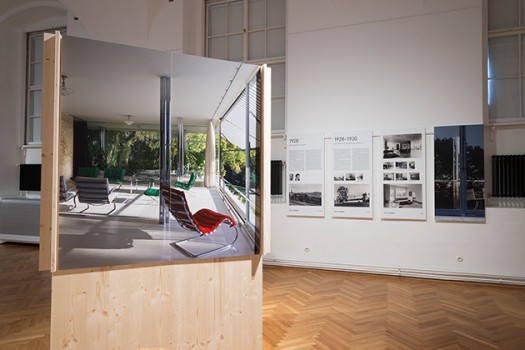Villa Tugendhat
21 Oct - 29 Nov 2015
VILLA TUGENDHAT
21 October – 29 November 2015
The Study and Documentation Centre at the Villa Tugendhat (SDC-VT) designed a traveling exhibition—financed by the Brno City Museum—in reaction to the public’s huge interest in the Villa Tugendhat after restoration was completed in 2012. Information boards, large-format photos, and a video documentary give visitors an insight into the building and its history.
In cooperation with the City of Brno, the team at the Villa Tugendhat, and the City of Vienna, the MAK will show this exhibition for the first time in Austria in the fall of 2015. After last year’s film and book presentation Tugendhat House, this is another initiative by the MAK to convey its affiliation with Brno and this masterpiece of Modernist architecture, which is now protected as a UNESCO World Heritage Site. Built in 1929–1930 by the German architect Ludwig Mies van der Rohe for Grete and Fritz Tugendhat, the villa is considered Mies van der Rohe’s most important pre-war work and the most authentically preserved building in Europe. The construction, layout of the rooms, interior design, and technical equipment all set new standards at the time.
Project Coordination (MAK): Rainald Franz, Curator, MAK Glass and Ceramics Collection
21 October – 29 November 2015
The Study and Documentation Centre at the Villa Tugendhat (SDC-VT) designed a traveling exhibition—financed by the Brno City Museum—in reaction to the public’s huge interest in the Villa Tugendhat after restoration was completed in 2012. Information boards, large-format photos, and a video documentary give visitors an insight into the building and its history.
In cooperation with the City of Brno, the team at the Villa Tugendhat, and the City of Vienna, the MAK will show this exhibition for the first time in Austria in the fall of 2015. After last year’s film and book presentation Tugendhat House, this is another initiative by the MAK to convey its affiliation with Brno and this masterpiece of Modernist architecture, which is now protected as a UNESCO World Heritage Site. Built in 1929–1930 by the German architect Ludwig Mies van der Rohe for Grete and Fritz Tugendhat, the villa is considered Mies van der Rohe’s most important pre-war work and the most authentically preserved building in Europe. The construction, layout of the rooms, interior design, and technical equipment all set new standards at the time.
Project Coordination (MAK): Rainald Franz, Curator, MAK Glass and Ceramics Collection


